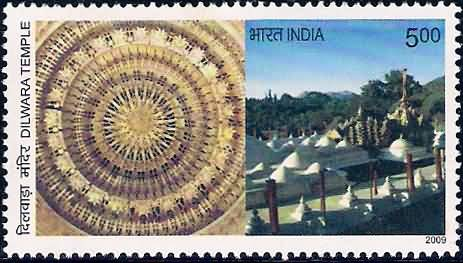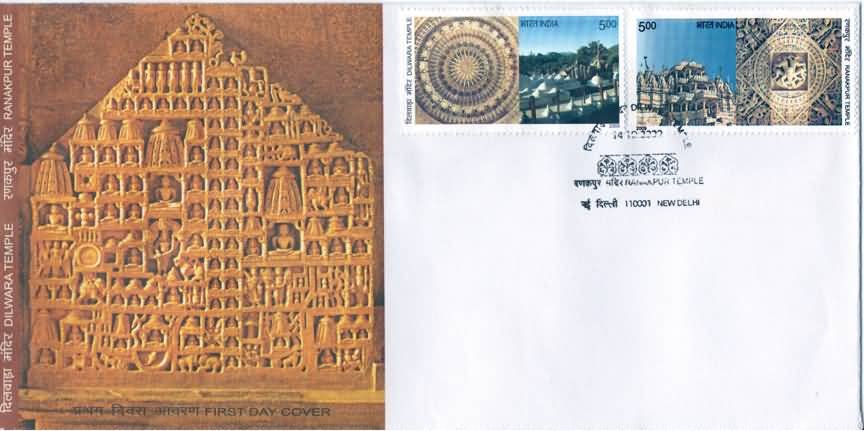Heritage Jain Temples- Dilwara

Technical Data
| Stamp Set | Heritage Jain Temples |
|---|---|
| Date of Issue | October 14, 2009 |
| Denomination | Rs. 5 |
| Quantity | 400,000 |
| Perforation | 13 |
| Printer | Security Printing Press, Hyderabad |
| Printing Process | Wet Offset |
| Watermark | No Watermark |
| Colors | Multicolor |
| Credit (Designed By) | Sh. Sankha Samanta |
| Catalog Codes |
Michel IN 2414 Stamp Number IN 2354 Stanley Gibbons IN 2635 WADP Numbering System - WNS IN067.2009 |
| Themes | Temples |
Dilwara Jain temples are known world over for its extraordinary architecture and marvelous marble stone carvings, some experts also consider it architecturally superior to the Taj Mahal. It seems fairly basic temple from outside but every cloud has a silver lining, the temple interior showcases the extraordinary work of human craftsmanship at its best. These temples were built between 11th to 13th century AD, The beautiful lush green hills surrounding the temple gives a very pleasant feeling. The ornamental details of marble stone carvings is phenomenal and unmatched, The minutely carved ceilings and the pillars are just amazing. All this was done at a time when no transport or roads were available at a height of 1200+ Mtrs in Mount Abu, Huge blocks of marble stones were transported on elephant backs from the Arasoori Hills at Ambaji to this remote hilly region of Mount Abu. Dilwara temples is also a popular Jain pilgrimage attraction.
Of the five shrines in this group, four are architecturally significant. They are built with white marble stones. Each has a walled courtyard. In the centre of the courtyard is the shrine with the image of the deity, Rishabhdev. Around the large courtyard, there are numerous small shrines, each housing a beautiful image of the Tirthankaras with a series of elegantly carved pillars from the entrance to the courtyard. The ministers of the Solanki rulers of Gujarat had constructed all these temples during 11th and 13th centuries A.D.
Vimal Vasahi is the oldest temple, which has been dedicated to Adinath, the first Jain Tirthankara. Vimal Shah, minister of the then Solanki ruler of Gujarat, built it in the year 1031 A.D. The special feature of this temple is it’s ceiling which is circular in eleven richly carved concentric rings. The central ceiling of the temple is adorned with magnificent carving and it culminates into an ornamented central pendant. The pendant of the dome tapers down forming a drop or point, like a lotus flower. This is an astonishing piece of work. It symbolizes the divine grace coming down to fulfill human aspirations. Figures of 16 Vidya Devis (goddesses of knowledge) are carved on the ceiling.
The other Dilwara temples are the Luna Vasahi, Vastupala and Tejapala, named after the ministers of the then Vaghela ruler of Gujarat who built them in 1230 A.D. Inspite of being plain and austere on the outside, the interiors of all these temples are covered with delicate carvings. Its most notable feature is that the brilliant intricacy and delicacy of the marble carving is so fine that in places the marble becomes almost transparent.
Dilwara temples are one of the best examples of craftsmanship, the genius of carving out so brilliant and intricate a shape out of a block of stone, such that it almost comes to life! The temple is a tourist’s paradise and a meditative sanctum for the devotees.
First Day Cover

